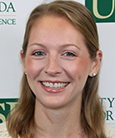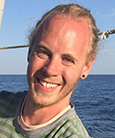Six graduate students at universities in Florida have received Guy Harvey scholarship awards, recognizing their outstanding achievement in marine fisheries science research. The following winners received $5,000 scholarships:
- Nicholas Ducharme-Barth, University of Florida
- Meaghan Faletti, University of South Florida
- Elizabeth Herdter, University of South Florida
- Bryan Keller, Florida State University
- Brian Moe, Florida State University
- Cheston Peterson, Florida State University
The scholarship, established in 2010 through a partnership between Florida Sea Grant and the Guy Harvey Ocean Foundation, recognizes students at Florida universities whose research focuses on the biology, ecology, habitat or management of fisheries in Florida’s marine environment. Since the award was established, $194,000 in scholarships has now been awarded to 41 students at nine different Florida universities.
Recipients also receive a certificate designed and signed by well-known marine wildlife artist and conservationist Guy Harvey. Thus far, awards have been given to students at the University of Florida, Florida State University, University of Central Florida, University of South Florida, University of Miami, University of North Florida, Florida Atlantic University, Florida International University and the Florida Institute of Technology.
“The recipients of the scholarship are the best and brightest of Florida’s college students who are conducting research dealing with marine fish or fisheries management issues,” said Karl Havens, director of Florida Sea Grant.
Greg Jacoski, director of the Guy Harvey Ocean Foundation, agreed. “We are delighted that this scholarship program is having such an impact, both in regard to supporting Florida college students and in supporting important research projects,” Jacoski said. “The partnership with Florida Sea Grant has been good for us, and good for aspiring marine science students and our oceans.”
This year’s research projects range from investigating the movement in hogfish in the Gulf of Mexico to evaluating predator-prey relationships of bonnethead sharks in Apalachicola Bay.

Nicholas Ducharme-Barth
Nicholas Ducharme-Barth is a Ph.D. student in the fisheries and aquatic sciences program within the University of Florida’s School of Forest Resources and Conservation. He is using spatial information associated with the Vessel Monitoring System data to gain a better understanding of the commercial reef fish fishery in the Gulf of Mexico.
“Analyzing movement patterns of vessels in the fishery gives a better idea of the factors that influence where commercial fishermen fish and what species they fish for,” Ducharme-Barth said. “This information can hopefully be used by managers to better understand the impacts that regulatory changes or other significant perturbing events have on the fishery.”
Ducharme-Barth spent the last two years working as a population and ecosystem dynamics fellow with the NOAA Fisheries/Sea Grant Joint Graduate Fellowship Program. He said the ability to use multiple disciplines to influence the health of the world’s fisheries is what drew him to the field of fisheries science.
“I find fisheries to be a fascinating and highly interdisciplinary field since it sits at the interface of humans and the ocean. The challenges are never the same and it often takes a mix of ecology, socioeconomics, and math to try and address them,” he said. “I would love to stay in this field as a stock assessment scientist and help provide scientific advice to ensure the continued sustainability of our marine resources.”
Rob Ahrens, an assistant professor of fisheries and aquatic sciences at UF said Ducharme-Barth’s project will provide critical data for fishery managers.
“His project may afford management the opportunity to understand how fishing efforts adjust in response to regulation changes,” Ahrens said. “Even a small advancement in this area will allow managers to explore if future regulation will achieve their intended objectives.”

Meaghan Faletti
Meaghan Faletti is a master’s student studying marine science in the Marine Resource Assessment Program at the University of South Florida College of Marine Science. She is investigating the movement of hogfish in the Gulf of Mexico as they age from juveniles to adults.
“I’m using a technique called stable isotope analysis on their eye lenses to retrospectively track their movement,” Faletti said. “It’s almost like having a built-in chemical tag inside the fish that traces where it’s been. This information can be used to aid in conservation and management of this species and habitats it relies on.”
Before starting her master’s degree, Faletti served as the lionfish outreach coordinator for the Florida Fish and Wildlife Conservation Commission where she planned two statewide events that resulted in divers removing more than 8,000 lionfish from state waters.
“This experience allowed me to communicate and work directly with the spearfishing community, encouraging involvement in lionfish control to mitigate the negative effects on native fish communities,” she said.
Faletti hopes to use this experience to involve the fishing community in her current research as much as possible.
“I hope to foster a sense of responsibility for protecting fish populations by inviting the public to participate in my research through collection of observational data and donating hogfish samples,” Faletti said. “I plan to facilitate communication among spearfishers, scientists and regulatory agencies to identify research needs and innovative approaches for fisheries management.”

Elizabeth Herdter
Elizabeth Herdter is a Ph.D. student in the Marine Resource Assessment Program at the USF’s College of Marine Science. She is evaluating age structure, growth patterns and abundance of juvenile spotted seatrout less than one year old.
“With this information I’ll be exploring the influence of temperature and rainfall on juvenile abundance of spotted seatrout,” said Herdter, who has previously worked as a stock assessment fisheries biologist for the Ocean Conservancy. “I plan on testing the use of environmental variables in future stock assessments for this fish. I am passionate about quantitative assessment because it is the foundation of fisheries management and resource sustainability.”
While pursuing her master’s degree, Herdter worked as an outreach coordinator for USF’s College of Marine Science Marine Science Advisory Panel. She said this position helped her develop important communication and leadership skills.
“I was able to use these skills while speaking with legislators and representatives to rally support for the National Ocean Policy and the Safety and Fraud Enforcement for Seafood Act during the 2014 Capitol Hill Ocean Week,” she said.
According to Steven Murawski, professor of population and ecosystem dynamics at USF, Herdter’s previous research, which evaluated the effects of the Deepwater Horizon Oil Spill on red snapper, has set the groundwork for her current study.
“She spent long hours at sea over five field seasons, capturing over 11,000 specimens of more than 100 species, including over 1,200 red snapper. This research has provided a foundation for her Ph.D. work on stock assessment and recruitment dynamics research,” Murawski said. “I know she will contribute much to the body of knowledge regarding dynamics of Gulf fishes and fisheries.”

Bryan Keller
Bryan Keller is pursuing a Ph.D. in biological oceanography at Florida State University. He is studying the seasonal migrations of coastal sharks.
“Many species of sharks migrate to and from the same locations each year, but we do not know how they achieve this success,” Keller said. “My work is focused on determining if these sharks use magnetic-based navigation, like using a compass, which is common in other marine animals like sea turtles.”
Keller, who grew up far from the ocean in Arizona, became interested in marine research after an unpleasant experience working at a fish store. As a 14-year-old, he was paid $5 an hour to smell astro snails in order to determine which individuals had survived the summer heat.
“Over the next five years, I grew thousands of dollars worth of coral from the small colonies I purchased with the money I made at the store,” Keller said. “These experiences motivated me to major in ecology and evolutionary biology at the University of Arizona.”
After earning his bachelor’s degree and working at an aquaculture lab at the university, Keller went on to receive his master’s degree in marine science at Coastal Carolina University. Before beginning his Ph.D. program, the certified scuba diver worked as a scientific director at Global Eco Adventures and as a team member for the Bimini Biological Field Station in the Bahamas.
Dean Grubbs, the associate director for research at FSU’s Coastal and Marine Laboratory, said Keller’s research has potential implications for conservation biology.
“The sensory modes and mechanisms used by marine animals for navigation and migration have been investigated for decades, but are largely unknown for sharks and their relatives.” Grubbs said. “Bryan has proposed to use a combination of state-of-the-art telemetry technologies and advanced geomatic modeling to conduct this research. I look forward to him progressing in my lab and predict he will become a productive member of the scientific and marine conservation communities.”

Brian Moe
Brian Moe is a Ph.D. student in biological science at Florida State University. His dissertation is focused on filling information gaps regarding the life history and population dynamics of deep-water shark species. To do this, he is also evaluating the use of near-infrared spectroscopy, or NIRS, as a non-lethal method to age sharks.
“We know very little about the biology and ecology of many deep-water species, which can pose a serious problem for the management of commercial fisheries that target these species,” Moe said. “Though the shark species I’m studying aren’t actively fished in the Gulf, the information I gather can be used to help manage fisheries in other parts of the world that do target these species, as well as inform future fisheries that may target stocks here in the Gulf.”
Moe’s passion for fisheries science was sparked during his undergraduate career at the University of Minnesota, where he earned his bachelor’s degree studying freshwater fisheries. While there he worked as a research assistant in Peter Sorenson’s lab focused on mitigating the effects of invasive Asian carp in the rivers and lakes of Minnesota. His experiences led him to spend a summer volunteering at the Bimini Biological Field Station in the Bahamas.
“This was the first time I had ever interacted with the marine environment,” Moe said. “I developed a love for marine ecosystems and their inhabitants, particularly the fishes.”
Charles Cotton, assistant research faculty at FSU’s Coastal and Marine Laboratory, said Moe’s research is using “cutting-edge techniques” to address pressing conservation and management needs.
“Brian’s doctoral research will fill basic information gaps for several data-deficient species. The exploratory spectroscopic ageing technique he intends to use has the potential to completely revolutionize studies of fish and age growth,” Cotton said. “Though this work includes some level of risk, the potential reward is tremendous in scope and hence well worth the investment of this scholarship.”

Cheston Peterson
Cheston Peterson is a Ph.D. student in biological science at Florida State University. He is studying how medium-sized predators make decisions about how to move and where to go based on the locations of their prey and predators.
“In other words, how do intermediate predators simultaneously find food and avoid being eaten?” Peterson explained. “To pursue this, I’m using passive acoustic telemetry and fishery-independent sampling to study how bonnethead sharks and gafftopsail catfish move throughout Apalachicola Bay relative to the densities of blue crabs, their primary prey, and the distribution and movements of bull sharks, their primary predator.”
Acoustic telemetry is a common underwater fish tracking method. It uses small acoustic tags implanted in fish to transmit signals, revealing a fish’s position to the researcher.
“This study will allow for continued research of fishery species in Apalachicola Bay − a large, river-dominated estuary that is important to the life stages of many economically and ecologically important species,” said Peterson, who has previously worked as a lab technician for North Carolina State University’s Center for Marine Sciences and Technology.
For the past four years, Peterson has helped lead the Gulf of Mexico States Shark Pupping and Nursery Area Survey operated by the NOAA/NMFS Fisheries Science Center in Panama City.
“Running our existing surveys has given Cheston the skills necessary to complete these goals and he is an extremely competent marine field biologist, even when dealing with the largest sharks that inhabit this region,” said Grubbs, who has been Peterson’s advisor at FSU since the start of the student’s master’s degree. “He is conducting research that is of great interest to the marine ecology community as well as to those interested in marine conservation.”
The Guy Harvey Ocean Foundation is an organization of philanthropists, conservationists, scientists and educators that emphasizes sensible strategies for promoting ocean conservation and the development of the next generation of marine scientists. The foundation funds research and educational programs developed by universities, colleges, institutes and nonprofit organizations. Learn more about the Guy Harvey Scholarships winners on our Current Fellows page, or learn more about the scholarship itself.



